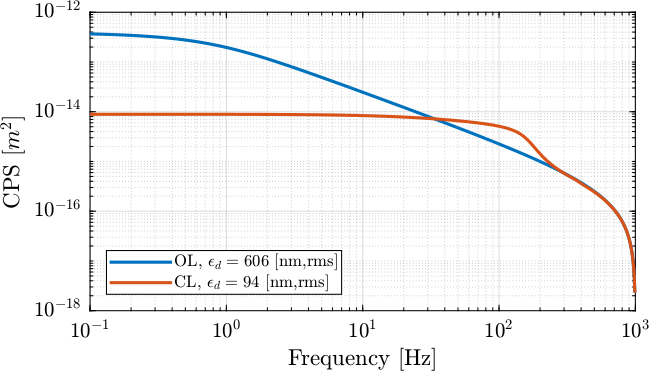54 KiB
ESRF Double Crystal Monochromator - Dynamical Multi-Body Model
- Introduction
- Open Loop System Identification
- Open-Loop Noise Budgeting
- Active Damping Plant (Strain gauges)
- Active Damping Plant (Force Sensors)
- Feedback Control
- HAC-LAC (IFF) architecture
- Bibliography
This report is also available as a pdf.
Introduction ignore
In this document, a Simscape (.e.g. multi-body) model of the ESRF Double Crystal Monochromator (DCM) is presented and used to develop and optimize the control strategy.
It is structured as follow:
- Section sec:open_loop_identification: the system dynamics is identified in the absence of control.
- Section sec:dcm_noise_budget: an open-loop noise budget is performed.
- Section sec:active_damping_strain_gauges: it is studied whether if the strain gauges fixed to the piezoelectric actuators can be used to actively damp the plant.
- Section sec:active_damping_iff: piezoelectric force sensors are added in series with the piezoelectric actuators and are used to actively damp the plant using the Integral Force Feedback (IFF) control strategy.
- Section sec:hac_iff: the High Authority Control - Low Authority Control (HAC-LAC) strategy is tested on the Simscape model.
Open Loop System Identification
<<sec:open_loop_identification>>
Introduction ignore
Identification
Let's considered the system $\bm{G}(s)$ with:
- 3 inputs: force applied to the 3 fast jacks
- 3 outputs: measured displacement by the 3 interferometers pointing at the ring second crystal
It is schematically shown in Figure fig:schematic_system_inputs_outputs.
\begin{tikzpicture}
% Blocs
\node[block] (G) {$\bm{G}(s)$};
% Connections and labels
\draw[->] ($(G.west)+(-1.5,0)$) node[above right]{$\begin{bmatrix} u_{u_r} \\ u_{u_h} \\ u_d \end{bmatrix}$} -- (G.west);
\draw[->] (G.east) -- ++(1.5, 0) node[above left]{$\begin{bmatrix} x_1 \\ x_2 \\ x_3 \end{bmatrix}$};
\end{tikzpicture}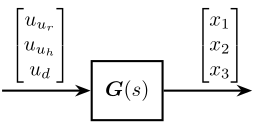
The system is identified from the Simscape model.
%% Input/Output definition
clear io; io_i = 1;
%% Inputs
% Control Input {3x1} [N]
io(io_i) = linio([mdl, '/control_system'], 1, 'openinput'); io_i = io_i + 1;
%% Outputs
% Interferometers {3x1} [m]
io(io_i) = linio([mdl, '/DCM'], 1, 'openoutput'); io_i = io_i + 1;%% Extraction of the dynamics
G = linearize(mdl, io);size(G)size(G) State-space model with 3 outputs, 3 inputs, and 24 states.
Plant in the frame of the fastjacks
load('dcm_kinematics.mat');Using the forward and inverse kinematics, we can computed the dynamics from piezo forces to axial motion of the 3 fastjacks (see Figure fig:schematic_jacobian_frame_fastjack).
\begin{tikzpicture}
% Blocs
\node[block] (G) {$\bm{G}(s)$};
\node[block, right=1.5 of G] (Js) {$\bm{J}_{s}^{-1}$};
\node[block, right=1.5 of Js] (Ja) {$\bm{J}_{a}$};
% Connections and labels
\draw[->] ($(G.west)+(-1.5,0)$) node[above right]{$\begin{bmatrix} u_{u_r} \\ u_{u_h} \\ u_d \end{bmatrix}$} -- (G.west);
\draw[->] (G.east) -- node[midway, above]{$\begin{bmatrix} x_1 \\ x_2 \\ x_3 \end{bmatrix}$} (Js.west);
\draw[->] (Js.east) -- node[midway, above]{$\begin{bmatrix} d_z \\ r_y \\ r_x \end{bmatrix}$} (Ja.west);
\draw[->] (Ja.east) -- ++(1.5, 0) node[above left]{$\begin{bmatrix} d_{u_r} \\ d_{u_h} \\ d_{d} \end{bmatrix}$};
\begin{scope}[on background layer]
\node[fit={(G.south west) ($(Ja.east)+(0, 1.4)$)}, fill=black!20!white, draw, inner sep=6pt] (system) {};
\node[above] at (system.north) {$\bm{G}_{\text{fj}}(s)$};
\end{scope}
\end{tikzpicture}
%% Compute the system in the frame of the fastjacks
G_pz = J_a_h*inv(J_2h_s)*G;The DC gain of the new system shows that the system is well decoupled at low frequency.
dcgain(G_pz)| 4.4407e-09 | 2.7656e-12 | 1.0132e-12 |
| 2.7656e-12 | 4.4407e-09 | 1.0132e-12 |
| 1.0109e-12 | 1.0109e-12 | 4.4424e-09 |
The bode plot of $\bm{G}_{\text{fj}}(s)$ is shown in Figure fig:bode_plot_plant_fj.
G_pz = diag(1./diag(dcgain(G_pz)))*G_pz;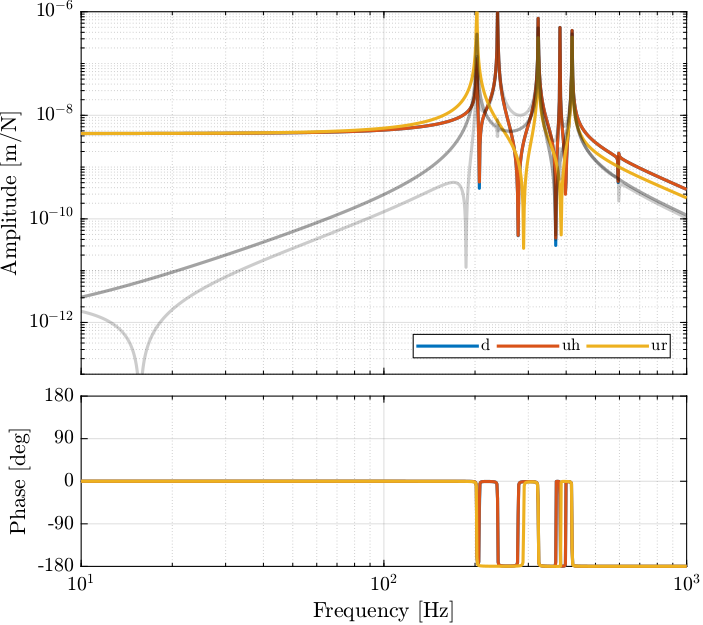
Computing the system in the frame of the fastjack gives good decoupling at low frequency (until the first resonance of the system).
Plant in the frame of the crystal
\begin{tikzpicture}
% Blocs
\node[block] (G) {$\bm{G}(s)$};
\node[block, left=1.5 of G] (Ja) {$\bm{J}_{a}^{-T}$};
\node[block, right=1.5 of G] (Js) {$\bm{J}_{s}^{-1}$};
% Connections and labels
\draw[->] ($(Ja.west)+(-1.5,0)$) node[above right]{$\begin{bmatrix} \mathcal{F}_{z} \\ \mathcal{M}_{y} \\ \mathcal{M}_{x} \end{bmatrix}$} -- (Ja.west);
\draw[->] (Ja.east) -- node[midway, above]{$\begin{bmatrix} u_{u_r} \\ u_{u_h} \\ u_d \end{bmatrix}$} (G.west);
\draw[->] (G.east) -- node[midway, above]{$\begin{bmatrix} x_1 \\ x_2 \\ x_3 \end{bmatrix}$} (Js.west);
\draw[->] (Js.east) -- ++(1.5, 0) node[above left]{$\begin{bmatrix} d_z \\ r_y \\ r_x \end{bmatrix}$};
\begin{scope}[on background layer]
\node[fit={(Ja.south west) ($(Js.east)+(0, 1.4)$)}, fill=black!20!white, draw, inner sep=6pt] (system) {};
\node[above] at (system.north) {$\bm{G}_{\text{cr}}(s)$};
\end{scope}
\end{tikzpicture}
G_mr = inv(J_s_r)*G*inv(J_a_r');dcgain(G_mr)| 1.9978e-09 | 3.9657e-09 | 7.7944e-09 |
| 3.9656e-09 | 8.4979e-08 | -1.5135e-17 |
| 7.7944e-09 | -3.9252e-17 | 1.834e-07 |
This results in a coupled system. The main reason is that, as we map forces to the center of the ring crystal and not at the center of mass/stiffness of the moving part, vertical forces will induce rotation and torques will induce vertical motion.
Open-Loop Noise Budgeting
<<sec:dcm_noise_budget>>
Introduction ignore
\begin{tikzpicture}
% Blocs
\node[block] (G) {$G(s)$};
\node[addb, left= of G] (adddu) {};
\node[block, left= of adddu] (K) {$K(s)$};
\node[addb={+}{}{}{}{-}, left= of K] (subL) {};
\node[addb, right= of G] (addd) {};
\node[addb, below right=0.8 and 0.6 of addd] (adddn) {};
% Connections and labels
\draw[->] (subL.east) -- (K.west);
\draw[->] (K.east) -- (adddu.west);
\draw[->] (adddu.east) -- (G.west);
\draw[->] (G.east) -- (addd.west);
\draw[->] (addd-|adddn)node[branch]{}node[above]{$y_{\text{fj}}$} -- (adddn.north);
\draw[->] (adddn.west) -| (subL.south) node[below right]{$y_{\text{fj},m}$};
\draw[<-] (adddu.north) -- ++(0, 1) node[below right]{$d_u$};
\draw[<-] (addd.north) -- ++(0, 1) node[below right]{$d_{\text{fj}}$};
\draw[<-] (adddn.east) -- ++(1, 0)coordinate(dn) node[above left]{$n_{\text{fj}}$};
\draw[->] (addd.east) -- (addd-|dn);
\end{tikzpicture}
Power Spectral Density of signals
Interferometer noise:
Wn = 6e-11*(1 + s/2/pi/200)/(1 + s/2/pi/60); % m/sqrt(Hz)Measurement noise: 0.79 [nm,rms]
DAC noise (amplified by the PI voltage amplifier, and converted to newtons):
Wdac = tf(3e-8); % V/sqrt(Hz)
Wu = Wdac*22.5*10; % N/sqrt(Hz)DAC noise: 0.95 [uV,rms]
Disturbances:
Wd = 5e-7/(1 + s/2/pi); % m/sqrt(Hz)Disturbance motion: 0.61 [um,rms]
%% Save ASD of noise and disturbances
save('mat/asd_noises_disturbances.mat', 'Wn', 'Wu', 'Wd');Open Loop disturbance and measurement noise
The comparison of the amplitude spectral density of the measurement noise and of the jack parasitic motion is performed in Figure fig:open_loop_noise_budget_fast_jack. It confirms that the sensor noise is low enough to measure the motion errors of the crystal.
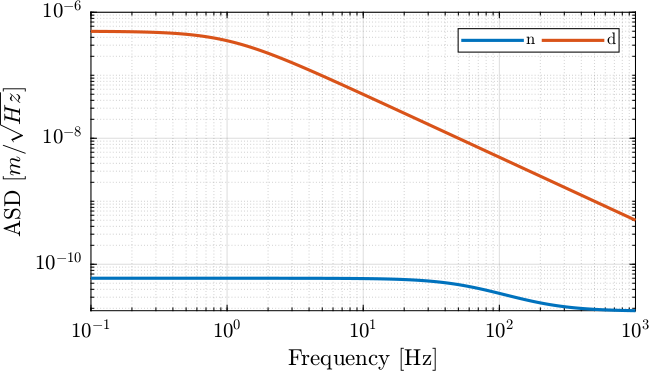
Active Damping Plant (Strain gauges)
<<sec:active_damping_strain_gauges>>
Introduction ignore
In this section, we wish to see whether if strain gauges fixed to the piezoelectric actuator can be used for active damping.
Identification
%% Input/Output definition
clear io; io_i = 1;
%% Inputs
% Control Input {3x1} [N]
io(io_i) = linio([mdl, '/control_system'], 1, 'openinput'); io_i = io_i + 1;
%% Outputs
% Strain Gauges {3x1} [m]
io(io_i) = linio([mdl, '/DCM'], 2, 'openoutput'); io_i = io_i + 1;%% Extraction of the dynamics
G_sg = linearize(mdl, io);dcgain(G_sg)| 4.4443e-09 | 1.0339e-13 | 3.774e-14 |
| 1.0339e-13 | 4.4443e-09 | 3.774e-14 |
| 3.7792e-14 | 3.7792e-14 | 4.4444e-09 |
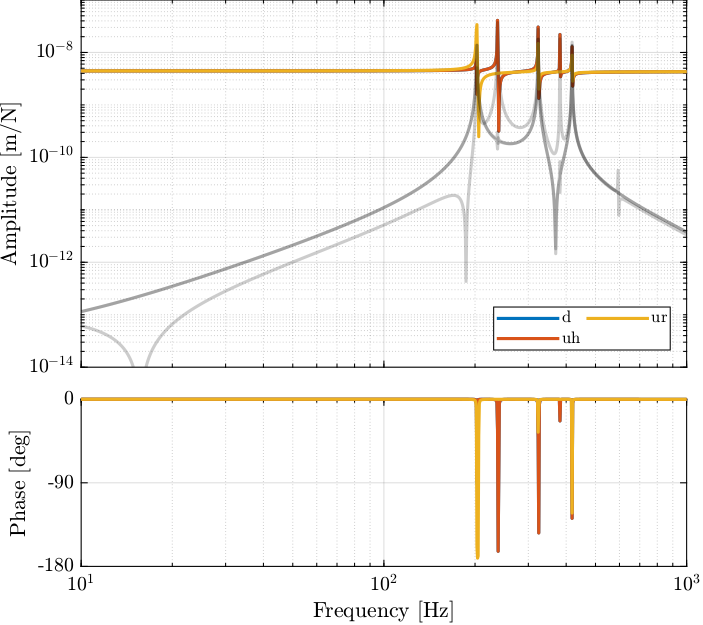
As the distance between the poles and zeros in Figure fig:iff_plant_bode_plot is very small, little damping can be actively added using the strain gauges. This will be confirmed using a Root Locus plot.
Relative Active Damping
Krad_g1 = eye(3)*s/(s^2/(2*pi*500)^2 + 2*s/(2*pi*500) + 1);As can be seen in Figure fig:relative_damping_root_locus, very little damping can be added using relative damping strategy using strain gauges.
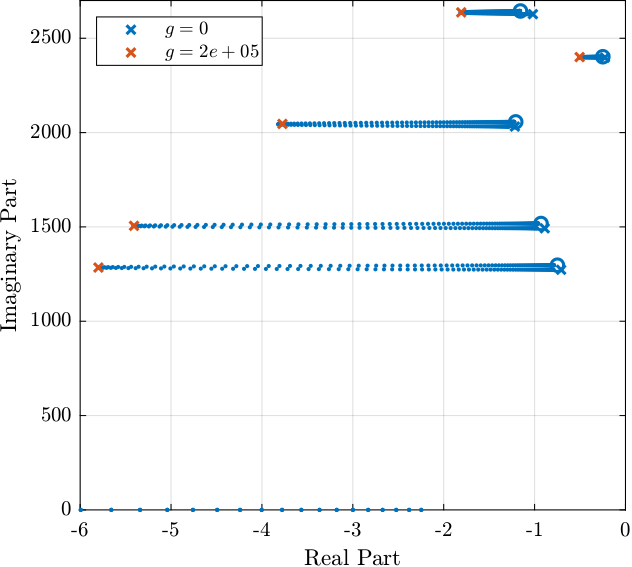
Krad = -g*Krad_g1;Damped Plant
The controller is implemented on Simscape, and the damped plant is identified.
%% Input/Output definition
clear io; io_i = 1;
%% Inputs
% Control Input {3x1} [N]
io(io_i) = linio([mdl, '/control_system'], 1, 'input'); io_i = io_i + 1;
%% Outputs
% Force Sensor {3x1} [m]
io(io_i) = linio([mdl, '/DCM'], 1, 'openoutput'); io_i = io_i + 1;%% DCM Kinematics
load('dcm_kinematics.mat');%% Identification of the Open Loop plant
controller.type = 0; % Open Loop
G_ol = J_a_r*inv(J_s_r)*linearize(mdl, io);
G_ol.InputName = {'u_ur', 'u_uh', 'u_d'};
G_ol.OutputName = {'d_ur', 'd_uh', 'd_d'};%% Identification of the damped plant with Relative Active Damping
controller.type = 2; % RAD
G_dp = J_a_r*inv(J_s_r)*linearize(mdl, io);
G_dp.InputName = {'u_ur', 'u_uh', 'u_d'};
G_dp.OutputName = {'d_ur', 'd_uh', 'd_d'};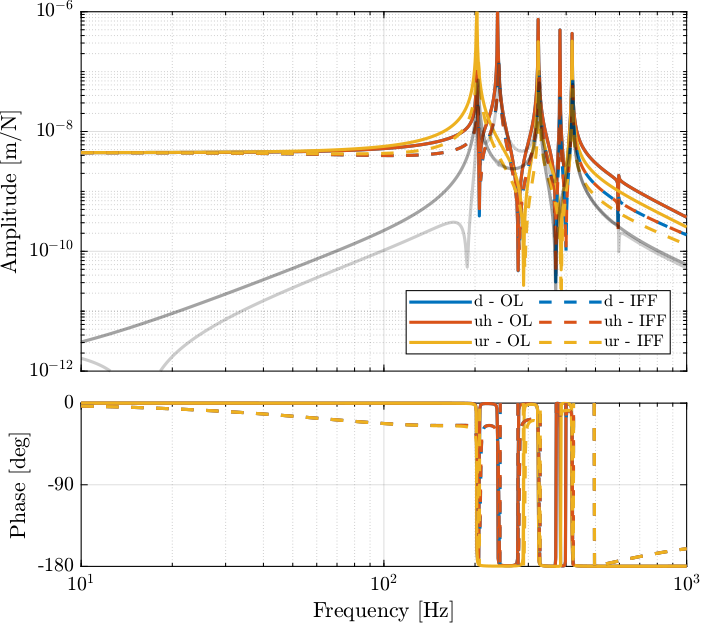
Active Damping Plant (Force Sensors)
<<sec:active_damping_iff>>
Introduction ignore
Force sensors are added above the piezoelectric actuators. They can consists of a simple piezoelectric ceramic stack. See for instance cite:fleming10_integ_strain_force_feedb_high.
Identification
%% Input/Output definition
clear io; io_i = 1;
%% Inputs
% Control Input {3x1} [N]
io(io_i) = linio([mdl, '/control_system'], 1, 'openinput'); io_i = io_i + 1;
%% Outputs
% Force Sensor {3x1} [m]
io(io_i) = linio([mdl, '/DCM'], 3, 'openoutput'); io_i = io_i + 1;%% Extraction of the dynamics
G_fs = linearize(mdl, io);The Bode plot of the identified dynamics is shown in Figure fig:iff_plant_bode_plot. At high frequency, the diagonal terms are constants while the off-diagonal terms have some roll-off.
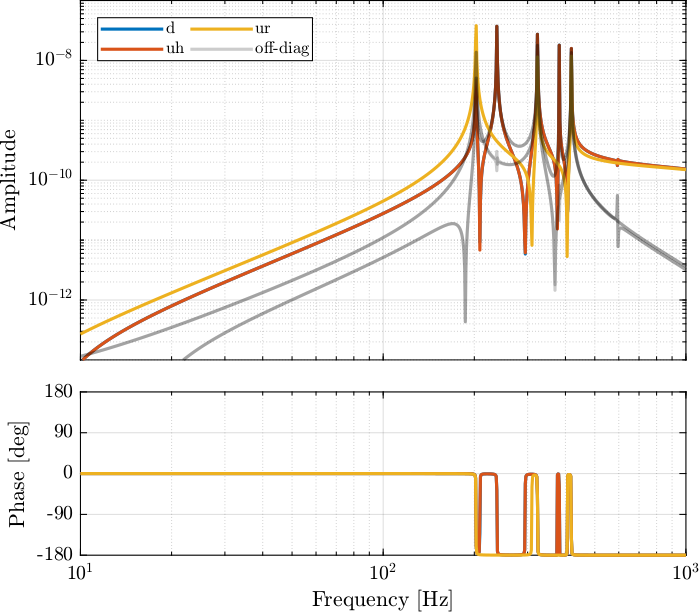
Controller - Root Locus
We want to have integral action around the resonances of the system, but we do not want to integrate at low frequency. Therefore, we can use a low pass filter.
%% Integral Force Feedback Controller
Kiff_g1 = eye(3)*1/(1 + s/2/pi/20);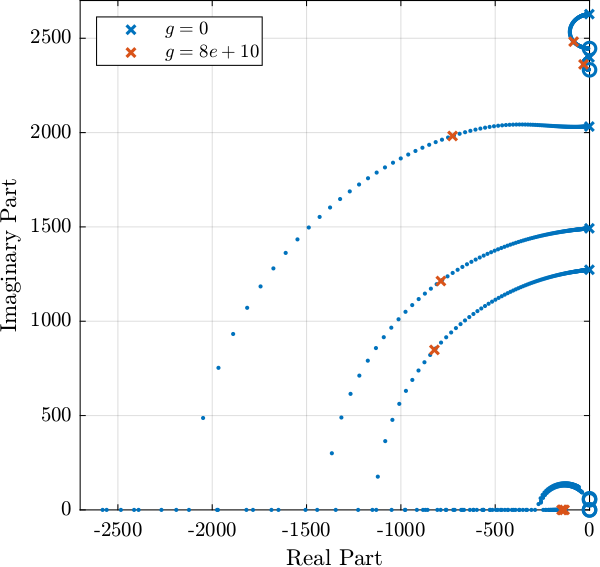
%% Integral Force Feedback Controller with optimal gain
Kiff = g*Kiff_g1;%% Save the IFF controller
save('mat/Kiff.mat', 'Kiff');Damped Plant
Both the Open Loop dynamics (see Figure fig:schematic_jacobian_frame_fastjack) and the dynamics with IFF (see Figure fig:schematic_jacobian_frame_fastjack_iff) are identified.
We are here interested in the dynamics from $\bm{u}^\prime = [u_{u_r}^\prime,\ u_{u_h}^\prime,\ u_d^\prime]$ (input of the damped plant) to $\bm{d}_{\text{fj}} = [d_{u_r},\ d_{u_h},\ d_d]$ (motion of the crystal expressed in the frame of the fast-jacks). This is schematically represented in Figure fig:schematic_jacobian_frame_fastjack_iff.
\begin{tikzpicture}
% Blocs
\node[block={4.0cm}{3.0cm}] (G) {$\bm{G}(s)$};
\coordinate[] (inputF) at ($(G.south west)!0.5!(G.north west)$);
\coordinate[] (outputF) at ($(G.south east)!0.8!(G.north east)$);
\coordinate[] (outputL) at ($(G.south east)!0.2!(G.north east)$);
\node[block, right=1.5 of outputL] (Js) {$\bm{J}_{s}^{-1}$};
\node[block, right=1.5 of Js] (Ja) {$\bm{J}_{a}$};
\node[addb, left= of G] (addF) {};
\node[block, above=0.5 of G] (Kiff) {$\bm{K}_{\text{IFF}}(s)$};
% Connections and labels
\draw[->] ($(addF.west)+(-1.5,0)$) node[above right]{$\begin{bmatrix} u_{u_r}^\prime \\ u_{u_h}^\prime \\ u_d^\prime \end{bmatrix}$} -- (addF.west);
\draw[->] (addF.east) -- node[miday, above]{$\begin{bmatrix} u_{u_r} \\ u_{u_h} \\ u_d \end{bmatrix}$} (inputF);
\draw[->] (outputF) -- ++(2.0, 0) node[above left]{$\begin{bmatrix} \tau_{u_r} \\ \tau_{u_h} \\ \tau_d \end{bmatrix}$};
\draw[->] ($(outputF) + (0.6, 0)$)node[branch]{} |- (Kiff.east);
\draw[->] (Kiff.west) -| (addF.north);
\draw[->] (outputL) -- node[midway, above]{$\begin{bmatrix} x_1 \\ x_2 \\ x_3 \end{bmatrix}$} (Js.west);
\draw[->] (Js.east) -- node[midway, above]{$\begin{bmatrix} d_z \\ r_y \\ r_x \end{bmatrix}$} (Ja.west);
\draw[->] (Ja.east) -- ++(1.5, 0) node[above left]{$\begin{bmatrix} d_{u_r} \\ d_{u_h} \\ d_{d} \end{bmatrix}$};
\begin{scope}[on background layer]
\node[fit={(G.south -| addF.west) (Ja.east |- Kiff.north)}, fill=black!20!white, draw, inner sep=6pt] (system) {};
\node[above] at (system.north) {$\bm{G}_{\text{fj,IFF}}(s)$};
\end{scope}
\end{tikzpicture}
The dynamics from $\bm{u}$ to $\bm{d}_{\text{fj}}$ (open-loop dynamics) and from $\bm{u}^\prime$ to $\bm{d}_{\text{fs}}$ are compared in Figure fig:comp_damped_undamped_plant_iff_bode_plot. It is clear that the Integral Force Feedback control strategy is very effective in damping the resonances of the plant.

The Integral Force Feedback control strategy is very effective in damping the modes present in the plant.
Feedback Control
\begin{tikzpicture}
% Blocs
\node[block={1.5cm}{1.5cm}] (G) at (0,0) {$\bm{G}(s)$};
\node[block, right=1.2 of G] (Js) {$\bm{J}_{s}^{-1}$};
\node[block, left=1.2 of G] (Khac) {$\bm{K}(s)$};
\node[block, left=1.2 of Khac] (Ja) {$\bm{J}_{a}$};
\node[addb={+}{}{}{}{-}, left=1.0 of Ja] (subL) {};
% Connections and labels
\draw[->] (Khac.east) -- node[midway, above]{$\begin{bmatrix} u_{u_r} \\ u_{u_h} \\ u_d \end{bmatrix}$} (G.west);
\draw[->] (G.east) -- node[midway, above]{$\begin{bmatrix} x_1 \\ x_2 \\ x_3 \end{bmatrix}$} (Js.west);
\draw[->] (Js.east) -- ++(1.0, 0);
\draw[->] ($(subL.west) + (-1.0, 0)$) -- node[midway, above]{$\begin{bmatrix} r_{d_z} \\ r_{r_y} \\ r_{r_x} \end{bmatrix}$} (subL.west);
\draw[->] (subL.east) -- node[midway, above]{$\begin{bmatrix} \epsilon_{d_z} \\ \epsilon_{r_y} \\ \epsilon_{r_x} \end{bmatrix}$} (Ja.west);
\draw[->] (Ja.east) -- node[midway, above]{$\begin{bmatrix} \epsilon_{d_{u_r}} \\ \epsilon_{d_{u_h}} \\ \epsilon_{d_d} \end{bmatrix}$} (Khac.west);
\draw[->] ($(Js.east) + (0.6, 0)$)node[branch]{}node[above]{$\begin{bmatrix} d_z \\ r_y \\ r_x \end{bmatrix}$} -- ++(0, -1.0) -| (subL.south);
\end{tikzpicture}
HAC-LAC (IFF) architecture
<<sec:hac_iff>>
Introduction ignore
The HAC-LAC architecture is shown in Figure fig:schematic_jacobian_frame_fastjack_hac_iff.
\begin{tikzpicture}
% Blocs
\node[block={3.0cm}{3.0cm}] (G) {$\bm{G}(s)$};
\coordinate[] (inputF) at ($(G.south west)!0.5!(G.north west)$);
\coordinate[] (outputF) at ($(G.south east)!0.8!(G.north east)$);
\coordinate[] (outputL) at ($(G.south east)!0.2!(G.north east)$);
\node[block, right=1.2 of outputL] (Js) {$\bm{J}_{s}^{-1}$};
\node[addb, left= of G] (addF) {};
\node[block, above=0.5 of G] (Kiff) {$\bm{K}_{\text{IFF}}(s)$};
\node[block, left=1.2 of addF] (Khac) {$\bm{K}_{\text{HAC}}(s)$};
\node[block, left=1.2 of Khac] (Ja) {$\bm{J}_{a}$};
\node[addb={+}{}{}{}{-}, left=1.0 of Ja] (subL) {};
% Connections and labels
\draw[->] (Khac.east) -- node[midway, above]{$\begin{bmatrix} u_{u_r}^\prime \\ u_{u_h}^\prime \\ u_d^\prime \end{bmatrix}$} (addF.west);
\draw[->] (addF.east) -- node[midway, above]{$\begin{bmatrix} u_{u_r} \\ u_{u_h} \\ u_d \end{bmatrix}$} (inputF);
\draw[->] (outputF) -- ++(2.0, 0) node[above left]{$\begin{bmatrix} \tau_{u_r} \\ \tau_{u_h} \\ \tau_d \end{bmatrix}$};
\draw[->] ($(outputF) + (0.6, 0)$)node[branch]{} |- (Kiff.east);
\draw[->] (Kiff.west) -| (addF.north);
\draw[->] (outputL) -- node[midway, above]{$\begin{bmatrix} x_1 \\ x_2 \\ x_3 \end{bmatrix}$} (Js.west);
\draw[->] (Js.east) -- ++(1.0, 0);
\draw[->] ($(subL.west) + (-0.8, 0)$) -- node[midway, above]{$\begin{bmatrix} r_{d_z} \\ r_{r_y} \\ r_{r_x} \end{bmatrix}$} (subL.west);
\draw[->] (subL.east) -- node[midway, above]{$\begin{bmatrix} \epsilon_{d_z} \\ \epsilon_{r_y} \\ \epsilon_{r_x} \end{bmatrix}$} (Ja.west);
\draw[->] (Ja.east) -- node[midway, above]{$\begin{bmatrix} \epsilon_{d_{u_r}} \\ \epsilon_{d_{u_h}} \\ \epsilon_{d_d} \end{bmatrix}$} (Khac.west);
\draw[->] ($(Js.east) + (0.6, 0)$)node[branch]{}node[above]{$\begin{bmatrix} d_z \\ r_y \\ r_x \end{bmatrix}$} -- ++(0, -1.0) -| (subL.south);
\end{tikzpicture}
System Identification
Let's identify the damped plant.

High Authority Controller
Let's design a controller with a bandwidth of 100Hz. As the plant is well decoupled and well approximated by a constant at low frequency, the high authority controller can easily be designed with SISO loop shaping.
%% Controller design
wc = 2*pi*100; % Wanted crossover frequency [rad/s]
a = 2; % Lead parameter
Khac = diag(1./diag(abs(evalfr(G_dp, 1j*wc)))) * ... % Diagonal controller
wc/s * ... % Integrator
1/(sqrt(a))*(1 + s/(wc/sqrt(a)))/(1 + s/(wc*sqrt(a))) * ... % Lead
1/(s^2/(4*wc)^2 + 2*s/(4*wc) + 1); % Low pass filter%% Save the HAC controller
save('mat/Khac_iff.mat', 'Khac');%% Loop Gain
L_hac_lac = G_dp * Khac;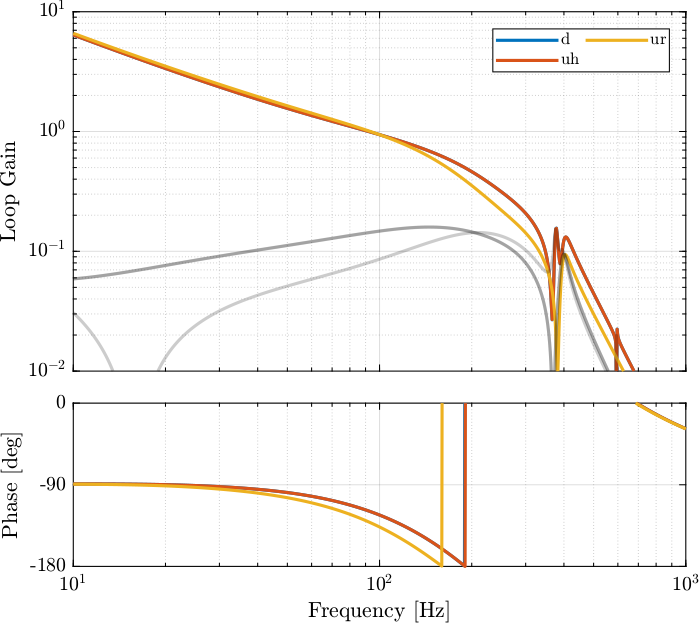
As shown in the Root Locus plot in Figure fig:loci_hac_iff_fast_jack, the closed loop system should be stable.

Performances
In order to estimate the performances of the HAC-IFF control strategy, the transfer function from motion errors of the stepper motors to the motion error of the crystal is identified both in open loop and with the HAC-IFF strategy.
It is first verified that the closed-loop system is stable:
isstable(T_hl)1
And both transmissibilities are compared in Figure fig:stepper_transmissibility_comp_ol_hac_iff.
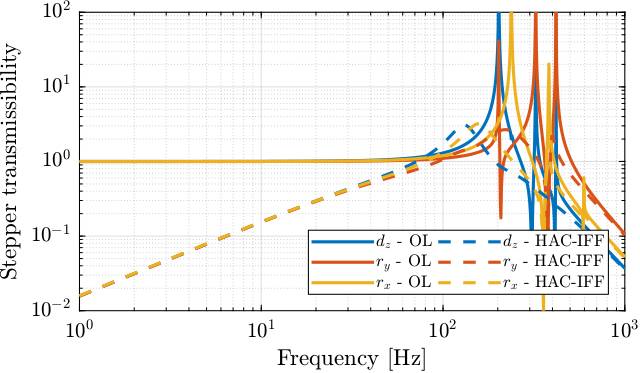
The HAC-IFF control strategy can effectively reduce the transmissibility of the motion errors of the stepper motors. This reduction is effective inside the bandwidth of the controller.
Close Loop noise budget
Let's compute the amplitude spectral density of the jack motion errors due to the sensor noise, the actuator noise and disturbances.
%% Computation of ASD of contribution of inputs to the closed-loop motion
% Error due to disturbances
asd_d = abs(squeeze(freqresp(Wd*(1/(1 + G_dp(1,1)*Khac(1,1))), f, 'Hz')));
% Error due to actuator noise
asd_u = abs(squeeze(freqresp(Wu*(G_dp(1,1)/(1 + G_dp(1,1)*Khac(1,1))), f, 'Hz')));
% Error due to sensor noise
asd_n = abs(squeeze(freqresp(Wn*(G_dp(1,1)*Khac(1,1)/(1 + G_dp(1,1)*Khac(1,1))), f, 'Hz')));The closed-loop ASD is then:
%% ASD of the closed-loop motion
asd_cl = sqrt(asd_d.^2 + asd_u.^2 + asd_n.^2);The obtained ASD are shown in Figure fig:close_loop_asd_noise_budget_hac_iff.
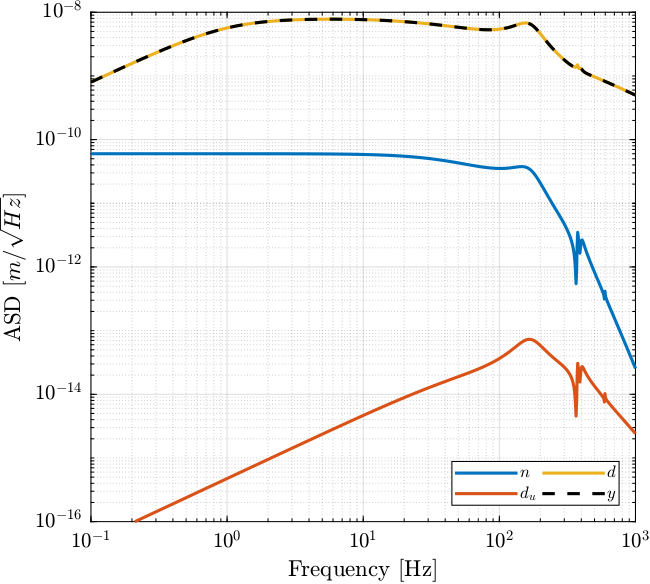
Let's compare the open-loop and close-loop cases (Figure fig:cps_comp_ol_cl_hac_iff).
